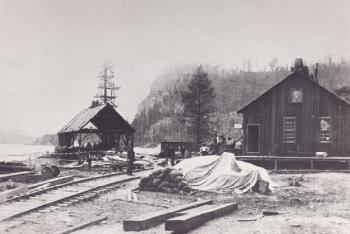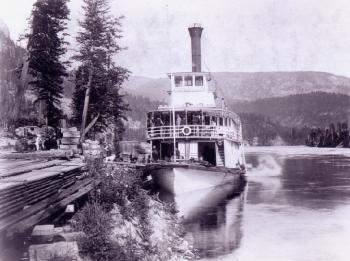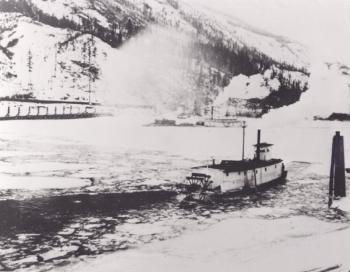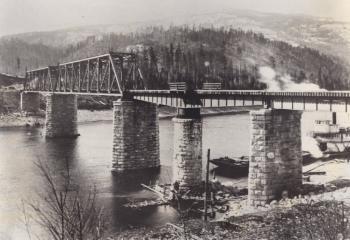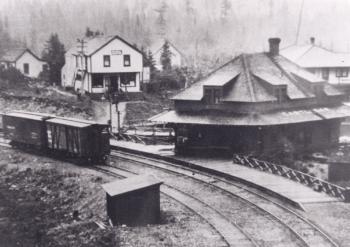 | ||||
A RAILROAD FROM NOWHERE TO NOWHERETwo years after completion of the Canadian Pacific Railway, Company president William Van Horne faced another challenge. With the discovery of the rich Silver King ore deposit near Nelson, Americans were quick to invade the area. The Columbia and Kootenay Rivers provided easy north-south transportation corridors; American railways advanced north to secure ore concentrates for the Spokane smelters. With a few shrewd moves, Van Horne was able to counteract the American pressures by gradually building up C.P.R. assets in this area. The very first asset was the Columbia and Kootenay Railway from Nelson to Sproat's Landing which van Horne referred to as "the railroad from nowhere to nowhere". This became the first segment of the southern trans-provincial railway.The last spike on the C.P.R. was driven at Craigellachie on November 7, 1885. As the echoes of the hammering died away in the solitude of Eagle pass that misty morning, the country to the south remained still largely unexplored and undeveloped. Within a few years, however, all this was to change. The major local event instrumental in attracting the attention of Van Horne to the Kootenay country was the discovery in late autumn of 1886 by Osmer and Winslow Hall of a rich silver deposit on the flanks of Toad Mountain, near Nelson. Not too far away, on Kootenay Lake, the Bluebell mine was already being worked profitably. In 1889 several rich silver-lead deposits were staked in the Ainsworth mining camp, directly across the lake. All these mineral discoveries led to a stampede of prospective miners and the inevitable speculators that followed on their heels. American railway magnates like Daniel Corbin and James Hill started making plans to push northward. There were several possible routes to get to the mineral-rich areas. From the south, the Columbia and Kootenay Rivers could be followed. A good pack trail existed from Fort Colville to the present site of Castlegar, at which point it crossed the Columbia to follow the Kootenay valley. The easiest route was probably from Revelstoke, downstream on the Columbia to Sproat's Landing. In 1888 Fred Hume, with two partners, started scheduled service from Revelstoke to Sproat's Landing with the steamer "Despatch". This venture was soon expanded into the Columbia and Kootenay Steam Navigation Company which quickly acquired additional steamers in order to cope with the rapidly increasing demand, especially after news of the fabulously rich strike on Red Mountain near Rossland broke in 1890.
Van Horne's first move was to construct a railway in 1891 from Nelson to Sproat's Landing, using the charter of the Columbia and Kootenay Railway. This was to transport mining freight to the C.K.S.N. steamers, hopefully to Revelstoke and the C.P.R. mainline. The terminus on the Columbia was quickly moved to Robson for a variety of reasons, the strongest being a better location which was less subject to flooding. This picture was soon complicated by Daniel Corbin building a railroad from Spokane to Northport and later (1893) to Nelson (the Nelson and Fort Sheppard Railway); thus it was easier to ship ores to Spokane for smelting. In 1896 Corbin built a short spur line (the Red Mountain Railway) to Rossland to haul ore concentrates to his smelter at Northport. The same year, however, an American entrepreneur, Fritz Augustus Heinze opened a smelter at Trail to handle the rich ores from nearby Rossland, as well as other areas such as the Slocan. He also applied for and was granted a charter to build a railway from Rossland to Trail, and then to the Okanagan to tie in with C.P.R. lines. If no suitable arrangement could be worked out with the C.P.R., his charter allowed him to go all the way to the coast. Work commenced in 1897 and the Columbia and Western Railway was constructed as far as Robson West. By this time C.P.R. had other irons in the fire. They realized that they could not depend on the C.K.S.N. to show them favoritism at the expense of other customers so they concluded that the long term solution to controlling freight to and from the Kootenay mines was to build a railway from their line at Lethbridge to Kootenay Lake via Crow's Nest Pass. This would also allow them to tap into the extensive coal deposits of the western foothills and ship the coal to the smelter at Trail. Two years in construction, the line was completed in December of 1898. 1898 was a pivotal year for the C.P.R. They were expanding simultaneously on several fronts. To join the race for the promising mines of the Boundary region, they immediately tackled the formidable task of extending the C.&W. westward along the precipitous shores of Lower Arrow Lake, climbing to a pass connecting to the Dog Creek valley. Working through the harsh winter of 1898-99 they were able to reach Grand Forks in Sept. of 1899 and Midway by 1900. It is inconceivable that this stretch of railway could have been done to such a high standard with such extensive and formidable rock retaining walls, culverts, and trestles in such a short time span. Thomas Shaunessey, who had by now replaced Van Horne as President, expressed his great satisfaction with the high construction standards during his inspection trip. He was less impressed by the temporary switchbacks over Bull Dog ridge; as his private coach derailed on the journey, he decided to walk the rest of the way. The switchbacks were replaced by the Bull Dog Tunnel in 1900. The same year also saw a significant expansion in Hill's Great Northern Railway network. He acquired controlling interest in Corbin's lines, thus gaining direct access to Rossland and Nelson. His narrow-gauge Kaslo and Slocan Railway was doing a booming business in the heart of the Slocan mining district. Plans were launched to connect Bonner's Ferry with Kuskonook on the southern end of Kootenay Lake. Other things were happening in 1898. To decrease dependence on the Columbia River- which created problems in the Narrows when water was too low in the summer, or turned to ice in the winter- a line was constructed from Slocan City to South Slocan. Via steamer service on Slocan Lake (which is too deep to freeze over), this line was connected to the Nakusp and Slocan Railway which had been tapping the Sandon mines for several years in direct competition to Hill's Kaslo and Slocan Railway. And in the same year, the "Minto", which was to be a local influence for over half a century, was launched at Nakusp.
To replace the inefficient barging system, plans were drawn up for the construction of a railway bridge at Sproat's Landing. The bridge, which incorporated a turnspan, was completed in 1902. It produced far reaching changes. Robson lost its importance as a railway depot, and a larger station house was built at Castlegar. The main steamer dock was established at Robson West, where direct connections with the trains could be made. Competition gradually withered away. The ill-conceived Bedlington and Nelson Railway proved to be draining business away from the Nelson and Ft.Sheppard line and the loss of the terminal at Kuskonook to a fire in 1900 led to early phasing out of the line. The Kaslo and Slocan Railway was destroyed by a forest fire in 1910. Only The Nelson and Fort Sheppard Railway kept operating on a limited basis, with passenger service to Spokane. Van Horne's dream- shared by Shaughnessy- of a second trans-provincial line close to the American border was fully realized when in 1916 Andrew McCulloch's monumental engineering marvel, the Kettle Valley Railroad was completed, linking the end of the Columbia & Western terminus at Midway with the C.P.R. main-line at Hope. Van Horne did not live to see its completion. He died in Montreal on September 11, 1915. Less than a year later, Van Horne's old adversary, James Hill died, on May 29, 1916. Two months later, on July 31, the first passenger train left Vancouver on its inaugural run to Nelson. Van Horne's "railway from nowhere to nowhere" was now linked to both the Atlantic and Pacific Oceans. | ||||
|
All rights reserved. Information is provided for personal use only. Use in any other application without permission is forbidden. |
